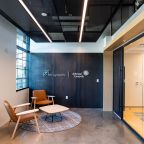In recent years, the evolution of smart technology has transformed many industries, and the workplace is no exception. As businesses adjust to a mix of remote and in-office work, using space efficiently is becoming more important. One of the most effective ways to achieve this is by integrating smart sensors with office space booking software.
This integration allows organizations to optimize their office environments, improve employee satisfaction, and enhance overall productivity. In this blog post, we will look at how to connect smart sensors with office booking software. We will discuss the benefits and answer some common questions.
Understanding Smart Sensors
Before delving into the integration process, let’s first understand what smart sensors are. Smart sensors are devices that gather data from their surroundings.
They send this data to a central system for processing and analyzing. They can detect various parameters, such as occupancy, temperature, light levels, and air quality. By leveraging this data, organizations can make informed decisions about their office spaces.
Types of Smart Sensors
- Occupancy Sensors: These sensors detect whether a room or area is occupied. They use technologies such as infrared, ultrasonic, or microwave to sense movement.
- Light Sensors: These sensors measure the ambient light levels in a space. They can help adjust artificial lighting based on natural light availability.
- Temperature and Humidity Sensors: These devices monitor the environmental conditions of a workspace, helping maintain a comfortable atmosphere.
- Air Quality Sensors: These sensors measure pollutants and other air quality factors. They help create a healthy work environment.
- Desk and Meeting Room Sensors: These sensors track how often desks or meeting rooms are used. They give insights into which spaces are popular.
Benefits of Integrating Smart Sensors with Booking Software
Integrating smart sensors with office space booking software provides numerous benefits:
1. Enhanced Space Utilization
By tracking real-time occupancy levels, organizations can better understand which areas of the office are underutilized or overcrowded. This data enables more efficient space allocation and can lead to cost savings on real estate.
2. Improved Employee Experience
Smart sensors can help create a more comfortable working environment. For example, by monitoring temperature and light levels, the system can automatically adjust settings to enhance comfort. Additionally, employees can easily find available spaces through the booking software, reducing frustration.
3. Data-Driven Decisions
Smart sensors collect data that shows usage patterns. This helps managers make better decisions about office layout, resource use, and future designs.
4. Increased Productivity
By ensuring that workspaces are conducive to productivity—through optimal lighting, temperature, and air quality—organizations can enhance employee performance and satisfaction.
5. Sustainability
Smart sensors can contribute to sustainability efforts by optimizing energy usage. For example, light sensors can turn off lights in unoccupied areas, reducing energy consumption.
How to Integrate Smart Sensors with Office Space Booking Software
The process of integrating smart sensors with office space booking software involves several key steps:
Step 1: Assess Your Needs
Before integration, assess your organization’s specific needs. Think about the types of spaces you need to monitor. Also, consider the data you want to gather and how you will use it. This assessment will help you choose the right sensors and software solutions.
Step 2: Select the Right Sensors
Choose smart sensors that align with your needs. Consider the following when selecting sensors:
- Compatibility: Ensure the sensors can integrate with your existing booking software.
- Data Accuracy: Look for sensors known for their reliability and precision.
- Scalability: Choose sensors that can be easily added or adjusted as your organization grows.
Step 3: Choose Office Space Booking Software
Select a booking software that can accommodate integration with smart sensors. Popular options include:
- Robin
- SpaceIQ
- FM:Systems
Ensure the software offers APIs or integration capabilities that allow communication with smart sensors.
Step 4: Establish Communication Protocols
Work with your IT team to establish communication protocols between the smart sensors and the booking software. This may involve using APIs, webhooks, or other integration methods to enable data exchange.
Step 5: Configure the System
Once the sensors and software are connected, configure the system to ensure the data flows correctly. Set up rules for how the booking software should respond to data from the sensors. If an occupancy sensor finds a room is empty, the software should automatically make it available for booking.
Step 6: Test the Integration
Before rolling out the integrated system, conduct thorough testing. Check that the system collects data accurately and that the booking software responds appropriately to sensor inputs. Address any issues that arise during this testing phase.
Step 7: Train Employees
Once the system is operating, provide training for employees on how to use the new tools. Ensure they understand how to book spaces and the benefits of the smart sensor integration.
Step 8: Monitor and Optimize
After implementation, continuously monitor the system’s performance. Analyze the data collected by the sensors to identify trends and make adjustments as needed. Regularly solicit feedback from employees to improve the system further.
Frequently Asked Questions (FAQs)
1. What types of smart sensors are best for office integration?
The best smart sensors for offices include:
- Occupancy sensors
- Light sensors
- Temperature sensors
- Humidity sensors
- Air quality sensors
The choice depends on what aspects of the office environment you want to monitor.
2. How much does it cost to implement smart sensors in an office?
The cost of implementing smart sensors varies widely based on the number of sensors needed, the type of sensors, and the office space size. Additionally, consider costs for the booking software and integration services. A rough estimate can range from a few thousand to tens of thousands of dollars.
3. How do smart sensors improve energy efficiency in an office?
Smart sensors improve energy efficiency by monitoring environmental conditions and adjusting systems accordingly. For example, occupancy sensors can turn off lights in empty rooms. Temperature sensors can adjust HVAC settings based on current conditions.
4. Can I integrate smart sensors with existing office space booking software?
Many modern office space booking solutions provide APIs and integration features. This allows smart sensors to connect with current software. Check with your software provider for specific integration options.
5. What data can I collect from smart sensors?
Smart sensors can collect various data types, including occupancy rates, light levels, temperature, humidity, and air quality metrics. This data can provide insights into space utilization and employee comfort.
6. How do I ensure employee privacy when using smart sensors?
To ensure employee privacy, choose sensors that do not collect personally identifiable information (PII). Create policies that outline how you will use data and ensure transparency with employees about your data collection practices.
7. What should I do if the system is not working as expected?
If the system is not functioning correctly, first check the connections and configurations. If issues persist, consult with your IT department or the sensor/software provider for technical support.
Conclusion
Combining smart sensors with office booking software can greatly improve workplace efficiency, employee comfort, and productivity. By leveraging real-time data, organizations can make informed decisions that lead to better space utilization, improved employee experiences, and sustainable practices. As the workplace changes, using smart technology will be important. This helps stay competitive and meet the needs of workers.
By following the steps in this blog post, your organization can prepare to create a smarter workplace. You will also find answers to common questions. This will help make your workplace more efficient.










